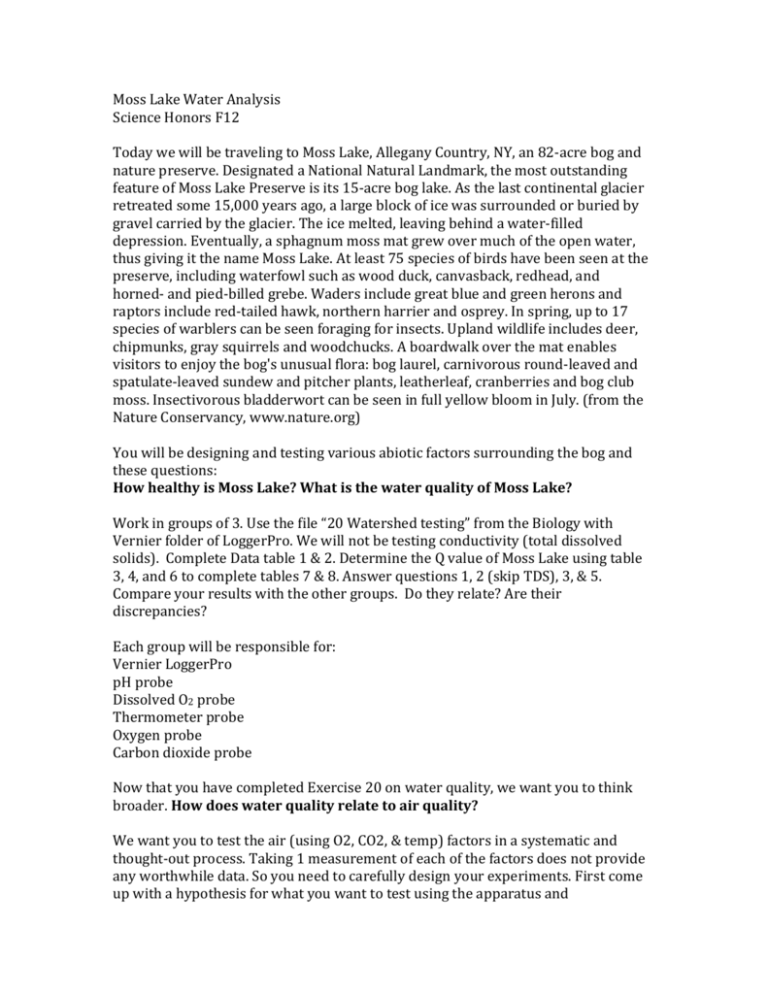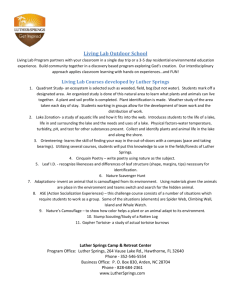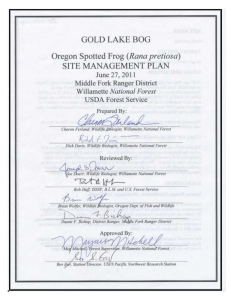Exploration
advertisement

Moss Lake Water Analysis Science Honors F12 Today we will be traveling to Moss Lake, Allegany Country, NY, an 82-acre bog and nature preserve. Designated a National Natural Landmark, the most outstanding feature of Moss Lake Preserve is its 15-acre bog lake. As the last continental glacier retreated some 15,000 years ago, a large block of ice was surrounded or buried by gravel carried by the glacier. The ice melted, leaving behind a water-filled depression. Eventually, a sphagnum moss mat grew over much of the open water, thus giving it the name Moss Lake. At least 75 species of birds have been seen at the preserve, including waterfowl such as wood duck, canvasback, redhead, and horned- and pied-billed grebe. Waders include great blue and green herons and raptors include red-tailed hawk, northern harrier and osprey. In spring, up to 17 species of warblers can be seen foraging for insects. Upland wildlife includes deer, chipmunks, gray squirrels and woodchucks. A boardwalk over the mat enables visitors to enjoy the bog's unusual flora: bog laurel, carnivorous round-leaved and spatulate-leaved sundew and pitcher plants, leatherleaf, cranberries and bog club moss. Insectivorous bladderwort can be seen in full yellow bloom in July. (from the Nature Conservancy, www.nature.org) You will be designing and testing various abiotic factors surrounding the bog and these questions: How healthy is Moss Lake? What is the water quality of Moss Lake? Work in groups of 3. Use the file “20 Watershed testing” from the Biology with Vernier folder of LoggerPro. We will not be testing conductivity (total dissolved solids). Complete Data table 1 & 2. Determine the Q value of Moss Lake using table 3, 4, and 6 to complete tables 7 & 8. Answer questions 1, 2 (skip TDS), 3, & 5. Compare your results with the other groups. Do they relate? Are their discrepancies? Each group will be responsible for: Vernier LoggerPro pH probe Dissolved O2 probe Thermometer probe Oxygen probe Carbon dioxide probe Now that you have completed Exercise 20 on water quality, we want you to think broader. How does water quality relate to air quality? We want you to test the air (using O2, CO2, & temp) factors in a systematic and thought-out process. Taking 1 measurement of each of the factors does not provide any worthwhile data. So you need to carefully design your experiments. First come up with a hypothesis for what you want to test using the apparatus and environment available (an 82 acre bog). Next think about how many readings (replicates) you will need to take for each variable, how many variables (abiotic factors) you will test (you must test 2 of the 3), how many unique locations you will test, (sites around the lake that are different, distances from the waters edge, different heights for air, etc). Think about how oxygen and carbon dioxide are related, how temperature affects its chemical composition, etc and how these relate to the health of an environment and the biotic factors therein. In your report include: A. Group members B. Hypothesis C. Methods (location, number of samples, depth/height, abiotic factors to test, biotic factors to observe) D. Data Answers to Questions: 1. How does the concentration of CO2 and O2 in the air relate to its temperature? 2. How does air temperature affect lake temperature? 3. How does air temperature affect lake dissolved oxygen concentration? 4. What type of lake is Moss Lake? (eutrophic, oligotrophic, or mesotrophic) why did you characterize it as such? 5. What stage of thermal stratification is the lake undergoing? What does that mean in terms of temperature and dissolved oxygen at the top versus in the middle and bottom of the lake?









